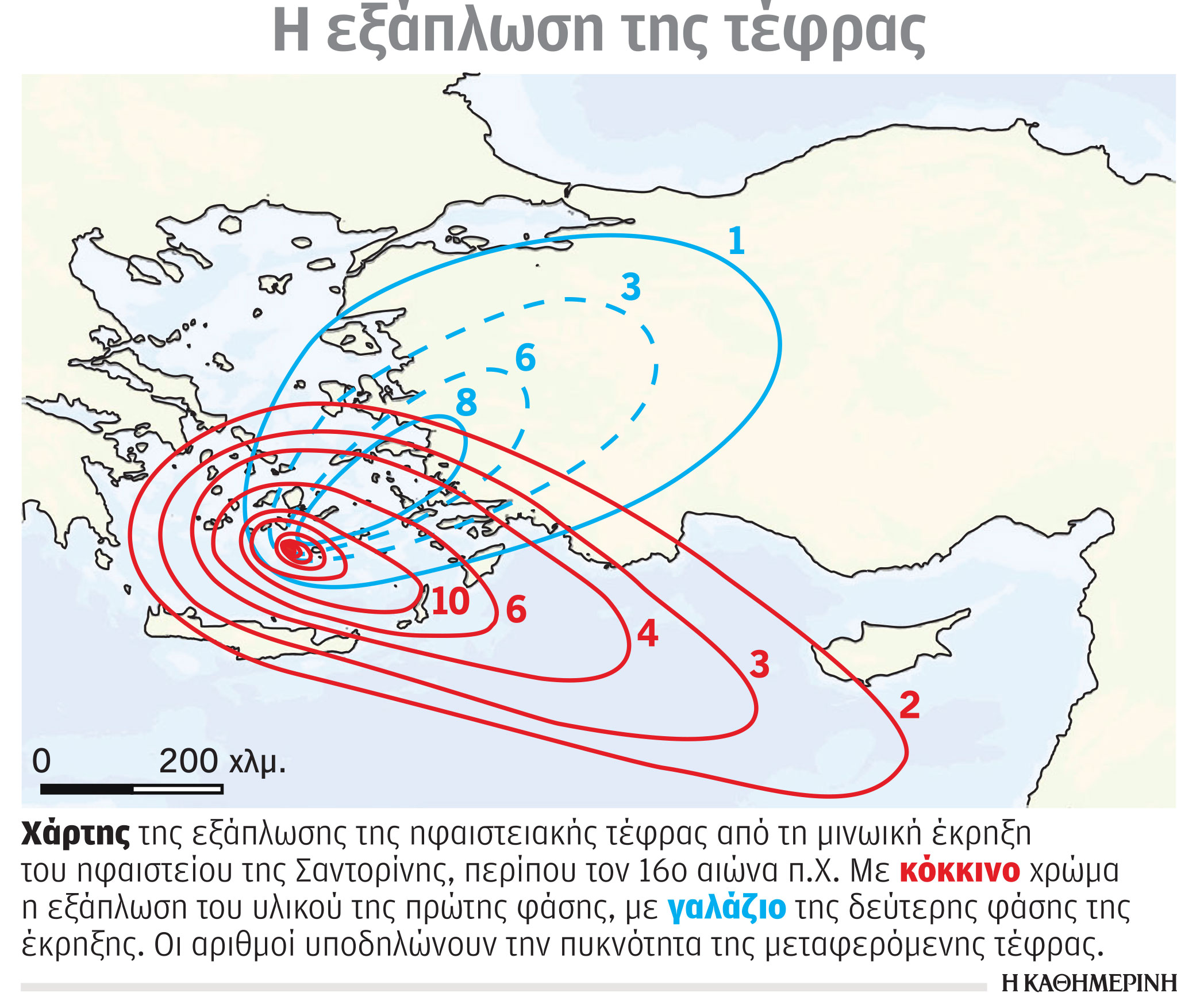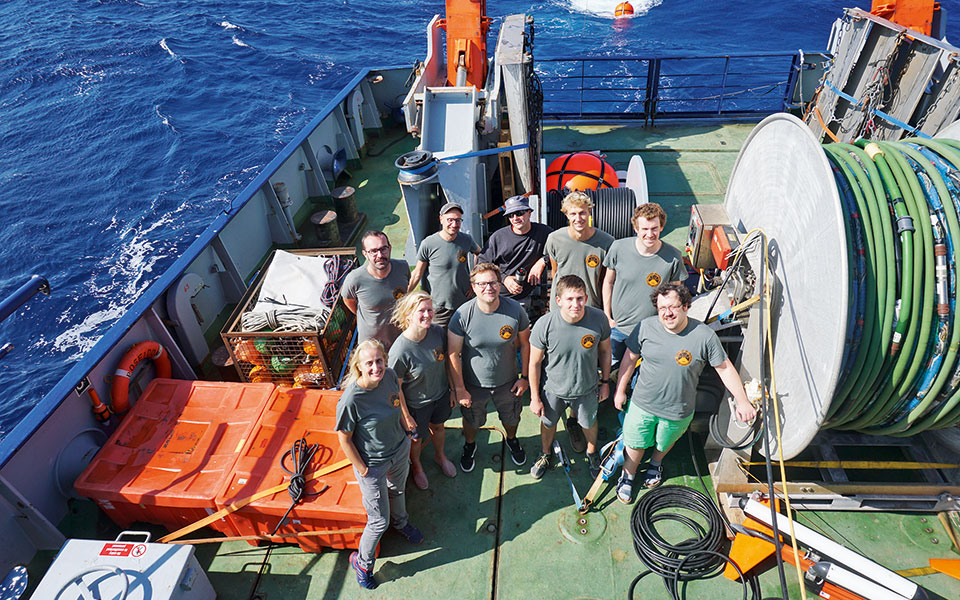
It is one of the most studied volcanoes in the world, and yet it continues to amaze us with new data obtained on the surface as a result of scientific research. The reason of that Volcano Santorini and the study of its “secrets” by an international research group with more or less the same core over the past 10-15 years. A group that, using more advanced technological tools and methodology, goes deeper into a particular analysis, even if this results in a revision of its previous estimates. “This is how science develops” says “K” Associate Professor of the Department of Geology and Geoecology of EKPA, Evie Nomikufrom members of the research team.
The focus was on magma erupted by the Minoan volcanic eruption of Santorini 3,600 years ago, which is considered the largest volcanic eruption in Europe in the last 10,000 years. The culmination of several years of work was the publication at the end of April 2023. Journal of Nature Communications, led by marine geologist Jens Carstens from the German Ocean Research Center GEOMAR Helmholtz in Kiel and with the participation of Ms. Nomiko and researchers from Norway, the USA and France. By combining the latest geophysical and geological techniques, scientists have re-examined the Minoan eruption of Santorini and more accurately determined the volume of erupted magma, contributing to understanding largest volcanic eruptions around the world. It should be noted that, despite their international significance for scientific work and society, the estimation of the volumes of products of large-scale volcanic eruptions remains limited.
Since 2002
The researchers in this new paper found that the volume of material ejected onto land and into Santorini’s underwater zone was 26-41 cubic kilometers, significantly less than previously thought when estimates were 86 cubic kilometers of ejected magma. “Our study is the result of several oceanographic expeditions since 2002 and the correlation of their results. During a research mission with the Poseidon vessel in 2017, material was collected from the bottom of the sea area around Santorini, at a depth of 6-12 meters, which was analyzed. Ash deposits from the Minoan eruption were found in 41 sediment cores, providing new data for calculating the amount of volcanic material. We re-planned the spread of the ash after the explosion based on the new data and saw how it moved mainly to the southeast, reaching below Cyprus, and in the second stage – to the east, into the depths of modern Turkey, “explains” K. “Miss Legal.

“In 2019, a new very large international oceanographic expedition, again with the participation of Greek scientists, explored seismic profiles, marine geophysical profiles, using sounding instruments that were able to fix various geological formations at depths of 1-1.5 kilometers. We compared seismic reflection and P-wave tomography data from another oceanographic mission in 2015 with sedimentological analysis to more accurately estimate the volume of the famous Minoan eruption,” adds Professor EKPA. The researchers had to take into account the amount of ash that fell to the ground, as well as the amount of pumice that fell into the water and floated away from the area. As the researchers note in their publication, such exact values are calculated for all individual components for the first time, since until now estimates of the volume of the eruption were based either on an estimate of the volume of the collapse caldera or on an underestimation of the explosion of its products. Both approaches have yielded limited results.
The amount of material turned out to be much less than previously thought – this is the conclusion of many years of research with the participation of Greek scientists.
Bottom
“An important element of this particular research project is that we have examined sediments at the bottom of the sea, where the volcanic material settles intact. It is important that from now on, important data on volcanic eruptions will come from the seabed, from marine data,” adds Ms. Nomiku. The data obtained and the method of correlation and calculation of final values are very interesting, since they provide new material for a deeper understanding of the work of volcanoes and more precise calculation of volcanic risk. As Ms. Nomiku notes, it is remarkable that although the material ejected from the Minoan eruption on Santorini was much less than expected, the destruction caused was very large.
Volcanic eruptions are classified on the basis of the volcanic explosiveness index (VEI), which depends on the amount of volcanic material, the height of the ash emission and the resulting column, the potential tsunami, and the explosive force. The Minoan eruption of Santorini ranked 5 to 6 on the scale (0 to 8), while 6 are the major eruptions of Krakatoa and Pinatubo.

“There should be no concern about the Santorini volcano. According to our analyzes, similar events like the one that happened 3,600 years ago could repeat every 20,000 to 30,000 years. In the meantime, there were other eruptions of the Santorini volcano, traces of which can be found in the layers that form the caldera. 197 BC type eruptions or later 1950 has nothing to do with the intensity of the Minoan Big Bang. We have learned to live with the volcano and will continue in the same spirit,” emphasizes the professor at the University of Athens.
“Excellent cooperation”
“This publication is the result of an excellent collaboration between Greek and foreign scientists who participated in earlier oceanographic expeditions around the Santorini submarine region. At the heart of research missions is a team of scientists with great shared experience and perfect collaboration. And it is important that it has Greek scientists and is surrounded by young researchers,” says Ms. Nomiku.
“Volcanoes warn they don’t explode suddenly”
Exploration in the wider area of Santorini does not stop. In two months, from December 2022 to January 2023, 12 subsea research wells were drilled around Thira at a depth of one kilometer as part of a large oceanographic mission of the International Ocean Exploration Program (IODP). Subsea drilling was carried out at points designated as critical by the research team after analyzing the seismic profiles and topography of the underwater floor, so that the volume of volcanic material from the Minoan Santorini eruption could also be confirmed by drilling. According to the members of the research team, this was a very important project, using a modern floating drilling rig and advanced tools, with a shipping cost of about 25 million euros, which resulted in very important research data. The corresponding report is planned to be made public at the end of July and is expected with great interest.
The active underwater volcano Kolumpos, located 6.5 km northeast of Thera, is also under surveillance. Columbus volcano became famous after a major volcanic eruption on September 27, 1650, which caused destruction and death of people, causing a tsunami with an impact radius of up to 150 km. . Sensors have been installed, geochemical data have been taken, there are cameras. We have a good understanding of the situation,” says Ms. Nomikou.

Scientists today are systematically working to integrate tectonics with the volcanic process.
As the EKPA professor of geology and geoecology explains, “Volcanoes are a warning. They don’t explode all of a sudden. First, a few months before, seismic shocks occur in the area, as the magma in its upward movement pushes the rocks and causes rearrangements. This process can begin a year before a volcanic eruption.”
Scientists today are systematically working to integrate tectonics with the volcanic process. Understanding the great events of the past, such as the Minoan eruption of the Santorini volcano, is a valuable legacy for clarifying the processes that are activated and develop. Many times you have had to go very far into the past in order to prepare for possible events in the distant future.
The rich research project that has developed over the years in Santorini highlights other aspects as well. For example, in samples from bottom sediments there are “imprints” of the conditions that existed thousands of years ago, the organisms that lived then. Based on these traces, one can draw conclusions about the climatic conditions that existed in previous centuries or millennia, and draw correlations with the ongoing process of climate change in our time.
Source: Kathimerini
Ashley Bailey is a talented author and journalist known for her writing on trending topics. Currently working at 247 news reel, she brings readers fresh perspectives on current issues. With her well-researched and thought-provoking articles, she captures the zeitgeist and stays ahead of the latest trends. Ashley’s writing is a must-read for anyone interested in staying up-to-date with the latest developments.